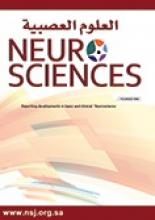To the Editor
I read with interest the study by Heydarian et al1 on the predicting factors and prevalence of meningitis in patients with first seizure, and fever aged 6 to 18 months. Obviously, bacterial meningitis (BM) remains one of the most important threats that must be considered in any febrile child presenting with seizure. Heydarian et al1 stated in their study that BM was detected in 6.25% of lumber puncture (LP) patients who had first attack of febrile seizure (FS). Also, they mentioned that factors predictive of meningitis in their studied cohort included postictal drowsiness, neurological deficit, body temperature >38.5˚C, white blood cell count ≥15000 mm3, and hemoglobin <10.5 gm/dl. Based on the presence of the aforementioned clinical and laboratory predictors of meningitis, they indirectly recommended performing LP for those presenting with first attack of FS. I presume that such indirect recommendation should be cautiously taken. This is based on the following 3 points. 1. The data addressed by Heydarian et al1 was taken from a single center and; hence, might not be truly representative of the whole pediatric population in Iran. Conducting large scale multicenter studies would better address the exact prevalence of meningitis and clinical and laboratory predictors of meningitis in patients with first attack of FS. 2. In the methodology of the study, Heydarian et al1 stated that their studied patients were divided into 2 groups. The first group involving cases with one tonic colonic seizure attack for less than 15 minutes was categorized as simple FS. The second group including cases with multiple attacks or seizures lasting more than 15 minutes, or had focal seizures was categorized as complex FS. Heydarian et al1 addressed that BM was detected at a higher rate (6.25%) compared with other studies. However, they did not mention the exact prevalence in each group of their studied patients. This is an essential prerequisite to be addressed to define whether that estimated prevalence is truly higher than that reported in other studies. The recently published systematic review and meta-analysis2 to estimate the risk of BM among various subgroups of young children with a first seizure has shown that in children with a first “seizure and fever,” the pooled prevalence of BM was 2.6% (95% confidence interval [CI] 0.9-5.1). In children with an apparent simple FS, the average prevalence of BM was 0.2% (range 0-1%). The pooled prevalence of BM among children with an apparent complex FS was 0.6% (95% CI 0.2-1.4).2 3. The recently published clinical reviews and updated American Academy of Pediatrics clinical guidelines for the management of children with simple FS obviously pointed out that if a child who is fully immunized according to the recommended schedule presents with a simple FS, minimal intervention should be the norm. Routine blood tests and routine LP are usually unnecessary, and the risks of neuro-diagnostic procedures (imaging or electroencephalography), prophylactic antipyretics, and anticonvulsants far outweigh their potential benefits.3 This guideline is further supported by the recently published systematic review and meta-analysis2 demonstrating that the utility of routine LP for the diagnosis of CNS infections requiring immediate treatment in children with an apparent first FS was low. The number of patients needed to test to identify one case of CNS infections was 1109 in children with an apparent first simple FS, and 180 in those with an apparent first complex FS.2
Reply from the Author
We thank Professor Al-Mendalawi for his valuable comments regarding our work. The following should be mentioned: 1. Our study was conducted in a referral teaching hospital where most patients with seizure and fever were admitted from other hospitals. 2. Although FS including simple or complex forms with its risk factors is common in children, identification of predicting factors and prevalence of meningitis in infants with apparently FS attack(s) is critical.4-8 Since we found that apparently the simple or complex form of FS was not a predictor of meningitis, but some other clinical and laboratory findings were among the predicting factors (including, postictal drowsiness, neurological deficit, body temperature ≥38˚5C, white blood cells ≥15000 mm3, and hemoglobin <10.5 gr/dl), these features should be emphasized as predictors of meningitis, including the bacterial form, instead of duration, or frequency, or form of seizures in febrile children.
Farhad Heydarian
Department of Pediatrics, Ghaem Hospital, Mashhad University of Medical Sciences, Mashhad, Iran
- Copyright: © Neurosciences
Neurosciences is an Open Access journal and articles published are distributed under the terms of the Creative Commons Attribution-NonCommercial License (CC BY-NC). Readers may copy, distribute, and display the work for non-commercial purposes with the proper citation of the original work.






